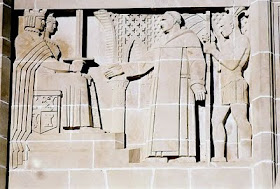1502 Leaves Spain for Hispaniola in the West Indies with the governor, Nicolas de Ovando. He earns an encomienda, a royal land grant populated with native peoples of the Indies, for his participation in several expeditions and then proceeds to evangelize the Indians.
1506 Returns briefly to Europe where he is ordained a deacon in Rome.
1511 On August 15, Pentecost Sunday, listens to a sermon by a Dominican priest, Father Antonio de Montesinos on the text "I am a voice crying in the wilderness," denouncing Spain's treatment of the Indians. As a result Las Casas returns his Indian serfs to the governor, urges other Spanish colonists, in his own preaching to do likewise, and spends the rest of his life in defense of the Indians.
1512 Becomes first priest to be ordained in the New World at Santo Domingo.
1513 Takes part in the violent and bloody conquest of Cuba and receives Indian serfs for his efforts.
1515 Returns to Spain to plead the Indian cause before King Ferdinand. Gains the support of the archbishop of Toledo, Francisco Jimenez de Cisneros, who names Las Casas as priest-procurator and "Protector of the Indies".
1516 In November returns to America as a member of a commission sent to investigate the treatment of the Indians.
1519 Returns to Spain once more.
1520 Presents a defense of the Indian to King Charles I (Emperor Charles V), arguing that the time of military conquest of the Indians has passed and that they could be converted by more peaceful means. After much debate the king sides with Las Casas and supports his plan to build a colony of farm communities in present-day Venezuela inhabited by both Spanish and free Indians. Las Casas sets sail in December.
1522 In January, after more than a year of continuous opposition of local encomenderos who incite Indian attacks on the farmers, the experiment fails.
1523 Disappointed in the results of his political activities, Las Casas joins the Dominicans in Santo Domingo and focuses his energy on writing. Over the next several years he writes several works including the treatise Concerning the Only Way of Drawing All Peoples to the True Religion and the beginnings of both Apologetica Historia de las Indias and Historia de Las Indias.
1530 Returns to Spain and obtains a royal decree prohibiting the enforcement of slavery in Peru, which he delivered personally.
1537 Receives some support from the Pope in the form of Paul III's bull Sublimis Deus, declaring the American Indians as rational beings with souls and the need for their lives and property to be protected.
1542 Returns to Spain where he convinces Charles I to signs the "New Laws" prohibiting Indian slavery: an attempt to put an end to the encomienda system by limiting ownership of serfs to a single generation. Writes his most influential and best known work, A Brief Account of the Destruction of the Indies, although it is said to be filled with inaccuracies. The report horrifies the court.
1544 To ensure enforcement of the laws he is named bishop of Chiapas in New Spain and sets sail in July. Upon arrival meets immediate opposition. Declares, in his tract Confesionario, that any Spaniard who refuses to release his Indians is to be denied absolution. Many members of the clergy refuse to follow this order. A year later the inheritance limitation is rescinded by Charles V.
1547 Returns to Spain and renounces his position as bishop of Chiapas, and becomes an influential figure at court and at the Council of the Indies. Begins conflict with Juan Gines de Sepulveda who defends Spain's treatment of the Indians on Aristotelian principles.
1550 At the order of Charles I he meets Sepulveda in the famous debate at the Council of Valladolid. While Las Casas convinces the theologians who preside over the debate and receives official approval, Sepulveda's teachings largely prevail in the Indies.
1552 Without clearance from the Inquisition, Las Casas publishes The Destruction of the Indies. Spends the next 14 years writing and appearing at court and councils in defense of the Indians.
1566 Dies in Madrid on July 18, and is buried in the convent chapel of Our Lady of Atocha.
1875 Historia de las Indias first published.

No comments:
Post a Comment
Note: Only a member of this blog may post a comment.